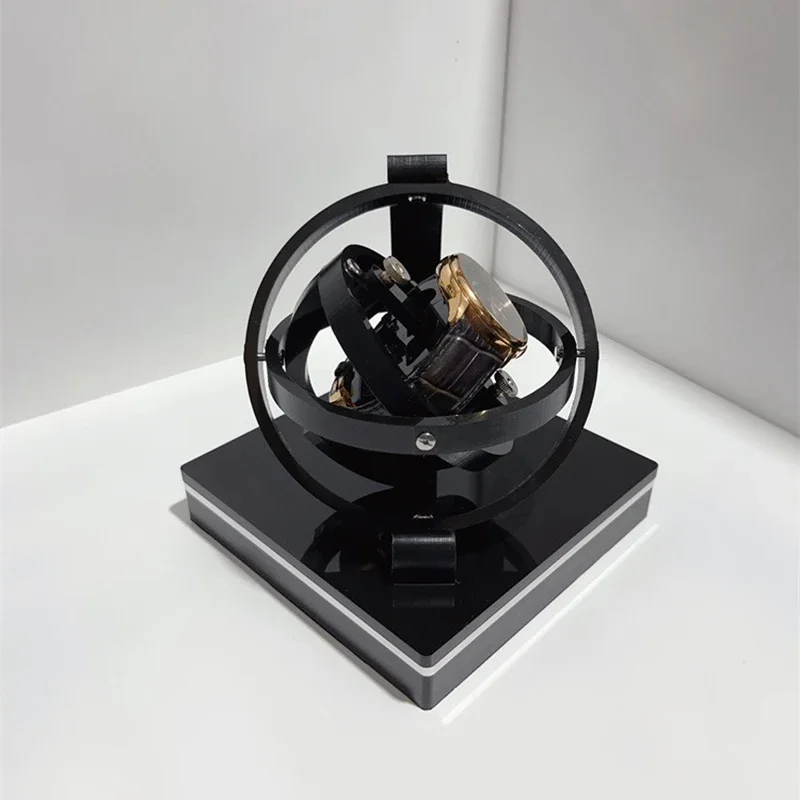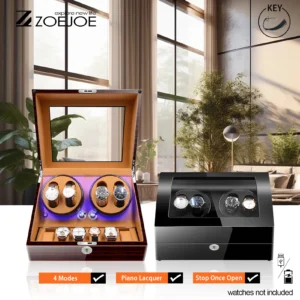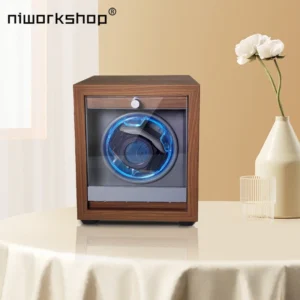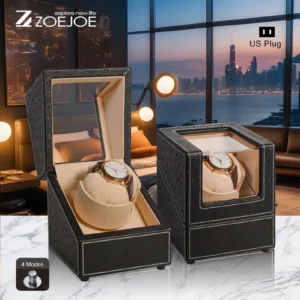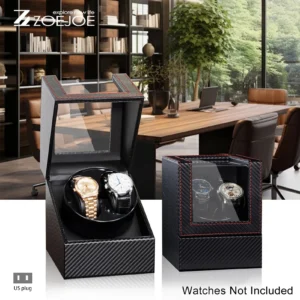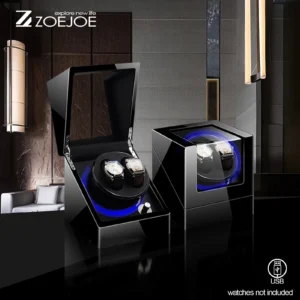Understanding Automatic Watch Winders and Why Settings Matter
An automatic watch winder is a specialized device designed to keep your automatic watches running when they’re not being worn. These clever devices mimic the natural motion of your wrist, maintaining the movement of the watch’s internal mechanisms. Automatic watches work through self-winding mechanisms that activate when the watch is in motion—whether on your wrist or on a quality watch winder.
Much like how a car engine needs regular operation to keep all parts properly lubricated, your automatic watch benefits from consistent movement. When an automatic watch sits motionless for extended periods, the lubricants inside can settle or dry out, potentially leading to decreased accuracy and increased wear over time.
The primary benefits of using watch winders are twofold: convenience and maintenance. From a convenience standpoint, your timepiece will always be ready to wear with the correct time and date. From a maintenance perspective, the regular movement helps distribute lubricants throughout the watch mechanism, preserving its longevity and accuracy.
However, not all automatic watch winder programming settings are created equal. Using incorrect settings can potentially cause more harm than good. The two key parameters that determine proper winder settings are Turns Per Day (TPD) and rotation direction—both of which need to be tailored to your specific watch model.
Finding the Right Setting: It Depends on Your Specific Watch
When it comes to watch winder settings, there’s no universal “best setting” that works perfectly for all timepieces. Different automatic watches have different needs based on their internal movement design, winding efficiency, and power reserve characteristics.
The two critical factors that determine the optimal settings are:
- Turns Per Day (TPD): This refers to the number of complete rotations your winder should make within a 24-hour period.
- Rotation Direction: Whether your watch should be rotated clockwise, counter-clockwise, or in both directions.
These settings vary across watch brands and even between different models from the same manufacturer. The differences stem from the unique design of each watch’s movement—some are more efficient at winding, while others require more motion to fully wind the mainspring.
If you’re unsure about your specific watch’s requirements, a generally safe starting point for most watches is 650-800 TPD with bi-directional rotation. However, for optimal care of your timepiece, finding the watch winder TPD settings guide specific to your model is highly recommended.
Turns Per Day (TPD): The Essential Setting Explained
TPD, or Turns Per Day, represents the number of complete rotations a watch winder makes within a 24-hour period. This setting directly relates to how much energy is transferred to your watch’s mainspring—the power source that keeps your watch running.
Every automatic watch has a specific power reserve, typically ranging from 36 to 72 hours, depending on the movement. This power reserve indicates how long your watch will continue running after being fully wound before it stops. The TPD setting ensures your watch receives enough motion to maintain its power reserve without excessive winding.
Common TPD ranges for different types of automatic watches include:
- Low-requirement watches: 450-650 TPD
- Medium-requirement watches: 650-850 TPD
- High-requirement watches: 850-1200+ TPD
Setting the TPD incorrectly can have consequences for your timepiece:
- If set too low: Your watch may not receive enough winding action, leading to power reserve depletion and your watch stopping or losing time.
- If set too high: While modern watches have mechanisms to prevent overwinding, unnecessarily high TPD settings can cause increased wear on the winding mechanism over time.
Understanding the TPD watch winders concept is crucial for maintaining your timepiece’s accuracy and longevity. The ideal TPD setting keeps your watch sufficiently powered without subjecting the movement to unnecessary stress.
Rotation Direction: Clockwise, Counter-Clockwise, or Bi-Directional
The second critical setting for any watch winder is the rotation direction. Watch winders typically offer three directional settings:
- Clockwise (CW): The winder rotates only in a clockwise direction
- Counter-Clockwise (CCW): The winder rotates only in a counter-clockwise direction
- Bi-Directional: The winder alternates between clockwise and counter-clockwise rotation
Which direction is right for your watch depends entirely on its internal winding mechanism. Automatic watches contain a semicircular weight called a rotor that swings with movement, winding the mainspring. Some rotors are unidirectional (wind in only one direction), while others are bidirectional (wind in both directions).
Bi-directional is the most common setting and generally the safest option when you’re unsure of your specific watch’s requirements. Most modern automatic watches have bidirectional winding mechanisms, making this setting suitable for the majority of timepieces.
Using the correct rotation direction ensures your watch winds efficiently. An incorrect direction setting for a unidirectional watch could result in insufficient winding, causing your watch to lose time or stop completely.
For detailed information on selecting the right rotation settings for your specific timepiece, many collectors refer to comprehensive ultimate guide automatic watch winder settings resources. Understanding these optimal watch winder settings will help ensure your precious timepiece remains accurate and well-maintained.
How to Find Your Watch’s Specific Winding Requirements
Finding the correct winding settings for your specific watch is an important step in proper timepiece care. Here’s a reliable hierarchy of sources to consult:
- Your watch’s manufacturer manual: This is the most authoritative source, often containing a technical specifications section with recommended winder settings.
- The manufacturer’s official website: Many luxury watch brands provide technical information about their movements online.
- Manufacturer customer service: Direct contact with the manufacturer can yield precise recommendations for your specific model.
- Online TPD databases and watch forums: Websites like WatchWinder.com and forums like WatchUSeek often have comprehensive databases of recommended settings.
- Professional watchmaker consultation: An experienced watchmaker can provide expert guidance based on your specific watch model.
Always prioritize information from official sources when possible. When searching manufacturer resources, look specifically for terms like “winding direction,” “rotor type,” or “recommended TPD.”
Understanding watch winder compatibility for your specific timepiece will help ensure you’re providing optimal care. Remember that finding the exact specifications is worth the effort—proper settings mean better performance and longevity for your watch.
Winding Settings for Popular Watch Brands
Below is a reference table of recommended winding settings for some of the most popular luxury watch brands. Please note that these are general guidelines, and specific models within each brand may have different requirements.
| Brand | Typical TPD Range | Preferred Rotation Direction |
|---|---|---|
| Rolex | 650-800 | Bi-directional |
| Omega | 650-800 | Bi-directional |
| TAG Heuer | 800-900 | Bi-directional |
| Seiko | 650-800 | Bi-directional |
| Breitling | 650-750 | Bi-directional |
| Patek Philippe | 800-900 | Bi-directional |
| Tudor | 650-800 | Bi-directional |
| IWC | 750-850 | Bi-directional |
While most modern automatic watches use bi-directional winding mechanisms, some specific movements are more efficient in one direction. Vintage watches especially may have unique requirements that differ from current models of the same brand.
When setting up your winder, consider the specifics of your watch winder settings movement type to ensure optimal results. For collectors with multiple timepieces, investing in quality automatic watch winders that offer adjustable settings for different watches is often the best solution.
Setting Up Your Watch Winder: Step-by-Step Guide
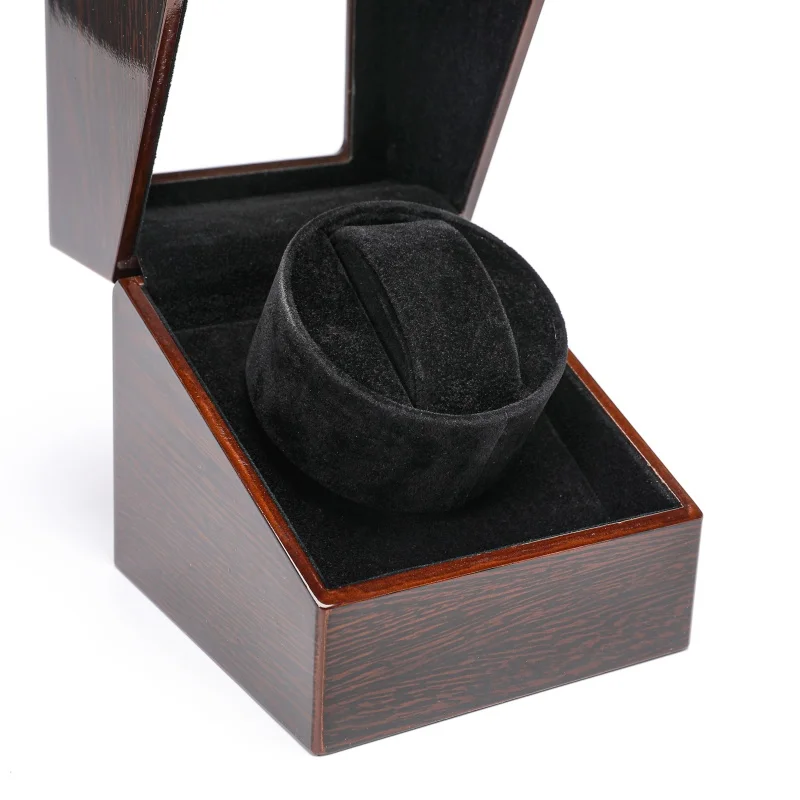
Follow these steps to properly set up your watch winder for optimal performance:
Fully wind your watch manually first: Before placing your watch on the winder, wind it manually by turning the crown 20-30 times (or until you feel resistance). This ensures your watch starts with a full power reserve.
Position your watch securely: Place your watch on the winder cushion or holder, making sure it’s properly secured. The watch should fit snugly but not be squeezed too tightly, which could damage the bracelet or strap.
Select the appropriate settings: Based on your research, set the TPD and rotation direction on your winder. If unsure, start with 650 TPD and bi-directional rotation as a safe default for most watches.
Monitor performance: Over the next 24-48 hours, check your watch’s accuracy against a reliable time reference. Note whether the watch maintains proper time or if it’s running fast or slow.
Make adjustments as needed:
– If your watch stops: Try increasing the TPD or changing the rotation direction
– If your watch gains/loses excessive time: Adjust TPD settingsFine-tune settings: Continue monitoring and making small adjustments until you find the optimal settings for your specific timepiece.
Learning how to program watch winder setup properly is crucial for maintaining your automatic watch’s accuracy and longevity. The process may require some patience, but finding the perfect settings will ensure your timepiece remains in optimal condition.
Debunking Common Watch Winder Myths
Several misconceptions about watch winders can lead to improper use. Let’s address some common myths:
Myth: Modern automatic watches can be overwound by winders.
Fact: Modern automatic watches have slip-clutch or similar mechanisms specifically designed to prevent overwinding. When the mainspring reaches full tension, these mechanisms allow the winding system to slip harmlessly.
Myth: Continuous winding is better than intermittent cycles.
Fact: Intermittent winding cycles that include rest periods more closely mimic natural wearing patterns and can be beneficial for your watch. Many high-quality winders offer programmable duty cycles for this reason.
Myth: Higher TPD settings are always better.
Fact: Using excessive TPD settings doesn’t provide any benefit and may cause unnecessary wear on the winding mechanism over time. The optimal setting is just enough to keep your watch powered.
Myth: All watches from the same brand require identical settings.
Fact: Different models from the same manufacturer often use different movements with varying winding requirements. Always check the specific requirements for your exact model.
For more information on addressing issues with your winding equipment, many owners find troubleshooting common watch winder problems resources invaluable for maintaining optimal performance.
Watch Winder Placement and Environmental Considerations
Where you place your watch winder and the surrounding environment can significantly impact both the winder’s performance and your watch’s condition:
Avoid direct sunlight and heat sources: Excessive heat can damage the winder’s motor and adversely affect your watch’s lubricants.
Keep away from strong magnetic fields: Items like speakers, refrigerators, or magnetic closures can magnetize your watch’s movement, affecting accuracy.
Maintain moderate humidity levels (40-60%): Too high humidity can cause condensation inside your watch, while too low humidity can dry out lubricants faster.
Place on stable surfaces: Vibration from unstable surfaces or nearby appliances can affect both the winder’s operation and potentially your watch’s accuracy.
Consider noise levels: If placed in a bedroom, the mechanical operation of some winders might be disruptive. Many luxury watch winders offer quiet operation specifically for this reason.
Environmental factors can significantly impact both your winder’s performance and your watch’s condition. Magnetic fields can affect timekeeping accuracy, temperature fluctuations can alter lubricant viscosity, and humidity extremes can damage sensitive components.
Benefits of Using Correctly Set Watch Winders
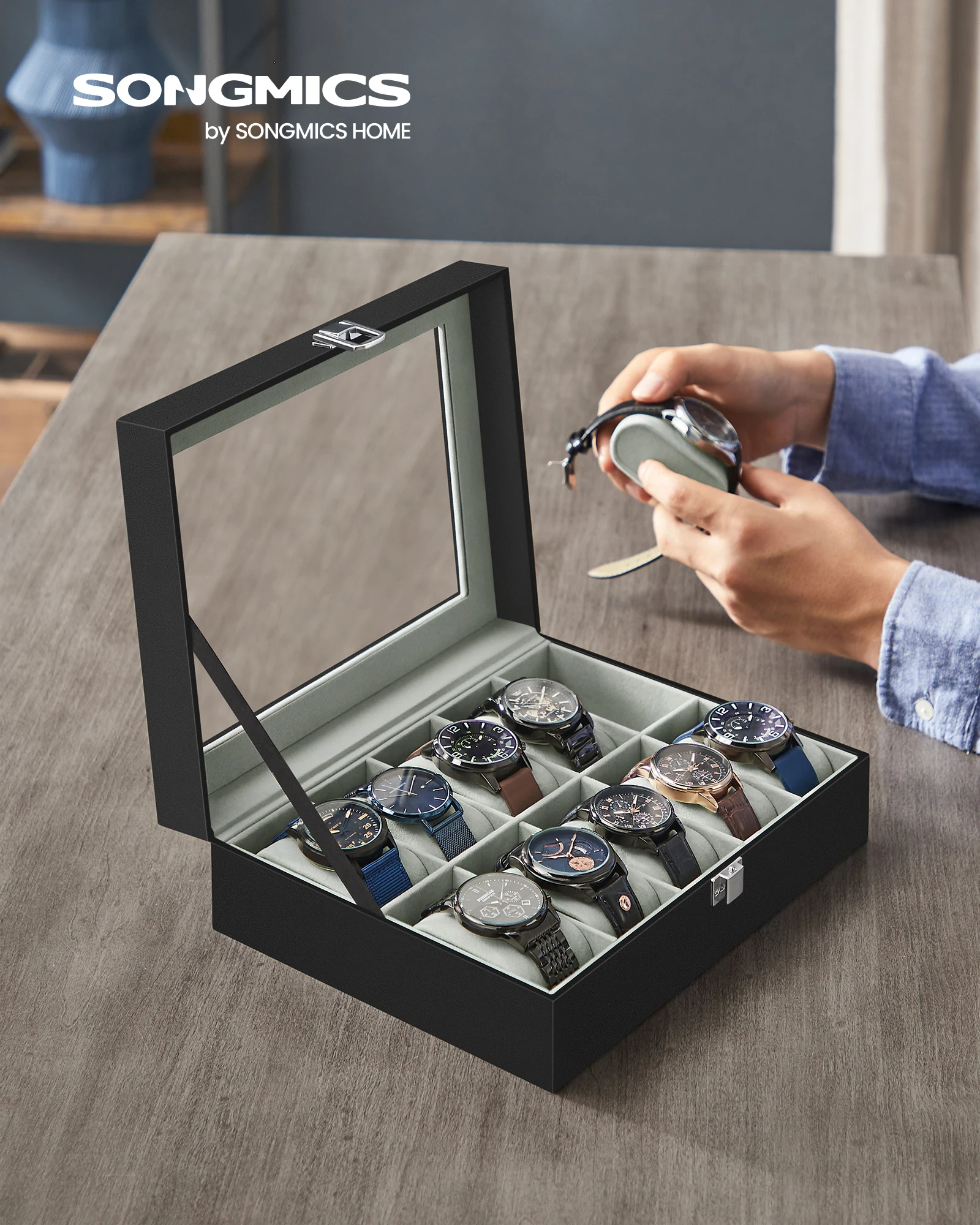
When properly configured, watch winders provide numerous benefits for automatic watch owners:
Convenience: Your watch is always ready to wear with the correct time and date, eliminating the need to reset it each time you wear it.
Movement accuracy maintenance: Regular operation helps the movement maintain its accuracy and proper function.
Lubricant distribution: Continuous gentle movement ensures oils and lubricants stay properly distributed throughout the movement, preventing them from settling or drying out.
Reduced manual setting wear: Less frequent setting of the time, date, and other complications reduces wear on those mechanisms, particularly important for watches with complex calendar functions.
Extended service intervals: Proper winding can help maintain your watch between professional service appointments.
Display functionality: Many single watch winders double as elegant display cases, allowing you to showcase your timepiece when not being worn.
Automatic Watch Winder, Luxury Watch Winder, Single Watch Box
$307.39 Select options This product has multiple variants. The options may be chosen on the product page4 Watch Winder, 6 Watch Box, Automatic Watch Winder
$512.31 Select options This product has multiple variants. The options may be chosen on the product pageAutomatic Watch Winder, Single Watch Winder, Wooden Watch Holder
$201.76 Select options This product has multiple variants. The options may be chosen on the product pageAutomatic Watch Winder, Leather Watch Travel Case, Single Watch Winder
$146.30 Select options This product has multiple variants. The options may be chosen on the product pageAutomatic Watch Winder, Double Watch Winder, Leather Watch Boxes
$147.60 Select options This product has multiple variants. The options may be chosen on the product pageAutomatic Watch Winder, Double Watch Winder
$206.18 Select options This product has multiple variants. The options may be chosen on the product page
Properly maintained automatic watches can provide decades of reliable service, making the investment in a quality watch winder and using the correct settings well worth it for serious collectors and casual enthusiasts alike.
Troubleshooting Common Watch Winder Issues
Even with careful setup, you might encounter occasional issues with your watch winder. Here are solutions to common problems:
Problem: Watch keeps stopping on the winder
Solution: First, check if your watch is fully wound before placing it on the winder. Then verify your TPD setting isn’t too low for your specific watch. Consider increasing the TPD by 100-200 turns or changing the rotation direction. If problems persist, your watch may need servicing.
Problem: Watch gaining/losing significant time
Solution: Minor time variations are normal, but significant gains or losses may indicate improper winder settings or that your watch needs regulation by a professional. Try adjusting the TPD setting slightly and monitor performance.
Problem: Winder not turning or operating inconsistently
Solution: Check the power source and connections. Ensure the winder is set to the correct program and that nothing is obstructing the rotation mechanism. If problems persist, contact the manufacturer.
Problem: Watch slipping in winder
Solution: Adjust the cushion size or tension to better secure your watch. Most quality winders include adjustable cushions or multiple cushion sizes to accommodate different watch sizes and bracelet/strap styles.
Understanding how to properly adjust watch winder movements for different timepieces can help resolve many common issues before they affect your watch’s performance.
Advanced Considerations for Watch Collection Management
For watch enthusiasts with multiple timepieces, collection management requires additional planning:
Rotation strategy: Consider rotating which watches are kept on winders, especially if you have more watches than winder slots. Many collectors keep their most complex watches (perpetual calendars, moon phases) on winders while manually winding simpler pieces when needed.
Winder scheduling: Some advanced winders offer programmable schedules, allowing you to set different winding patterns for different days or times. This can more closely mimic actual wearing patterns.
Energy efficiency: For continuous operation, consider the power consumption of your winder. Many modern winders offer sleep modes or energy-efficient motors to reduce consumption.
Long-term storage: For watches that will be stored for extended periods, consider whether continuous winding or periodic manual winding is more appropriate based on the specific watch.
For collectors with valuable collections, implementing proper safe watch storage protection measures alongside winding considerations ensures your timepieces remain in optimal condition both mechanically and aesthetically.
When Not to Use a Watch Winder
While watch winders are valuable tools for many collectors, there are situations where they may not be necessary or beneficial:
Daily-worn watches: If you wear a particular watch every day, it will maintain winding naturally from your wrist movement, making a winder unnecessary.
Non-automatic watches: Quartz watches or manually-wound watches don’t benefit from watch winders. In fact, keeping a manual wind watch on a winder could potentially cause damage.
Vintage timepieces: Some delicate vintage watches with original movements may benefit more from periodic manual winding rather than continuous winder use. Consult with a specialist watchmaker about vintage pieces.
During service periods: Watches undergoing professional servicing or repair should be removed from winders.
Alternative storage options for watches not requiring winders include watch boxes with proper cushioning, watch rolls for travel, or watch safes for high-value collections. These provide protection without the movement that watch winders provide.

